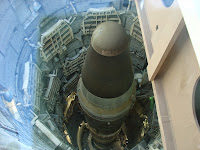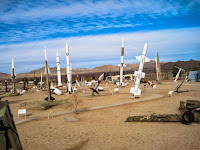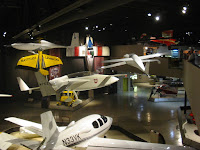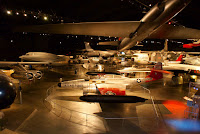One of the consequences of this anxiety is that I don't fly. When I tell people that I don't fly, they usually assume it to be a fear of flight; and then those who know me and my fascination with aviation find it incongruous. In fact, I have no fear of flight, and would quite happily go up in all kinds of flying machines that probably nobody in their right mind should. It's getting through the security checkpoints and customs at airports that freaks me out (and which becomes, as you can imagine, a vicious circle). So there's a lot of the world I would like to see but haven't.
I don't yet have any plan for doing anything about this. But maybe dreaming, and engaging with my motivations is a start (as it was for the body transformation).
A couple of family members are planning a trip to the United States next year. I have no intention of joining them for that. But their plans did get me thinking about what would I like to see in the United States if I were ever to go there? I tried to make a list of 10 things, but it ended up being 17. I also couldn't rank them: the top couple are easy, but after that, ranking became difficult but also pretty irrelevant.
So here are 17 places I'd like to visit in the USA, presented in order of increasing longitude.
 |
| Photo by Fawcett5 via Wikipedia Released into the public domain |
Seattle, Washington
[location] [website] [Wikipedia]
The Museum of Flight is one of the largest privately-operated aerospace museums in the world, with around 150 aircraft and spacecraft in its collection. The museum has strong ties to Boeing, and preserves the "Red Barn", a two-storey wooden building that was Boeing's original manufacturing facility. These ties also manifest in the museum's collection, which contains examples of most significant Boeing aircraft, including the 737 and 747 prototypes and reproductions of Boeing's earliest designs. The museum is even home to the mockup of the Boeing 2707, the manufacturer's abortive supersonic airliner of the 1970s (albeit currently in their off-site storage facility). This is a must-see for its collection of commercial transport aircraft.
 |
| USAF photo In the public domain |
Edwards Air Force Base, California
[location] [website] [Wikipedia]
What this museum lacks in size, it more than makes up for in "exotic". It's located on Edwards Air Force Base itself, where the United States has tested advances in aeronautical technology for 70 years. The highlights of the collection are the experimental aircraft (including many "X-planes") or their replicas preserved here, together with the prototypes of other aircraft that later made it into mass production. By their nature, most of the aircraft at this museum are one-of-a-kind and historic, and include such delightful oddities as the X-36 and X-48.
.jpg) |
| Photo by Dustin May CC-BY-SA |
Chino, California
[location] [website] [Wikipedia]
Planes of Fame houses a collection of rare and unusual aircraft. Many of them are military aircraft of the Axis powers of World War II, rescued from scrapping by the museum's founders after the US military had finished evaluating them. In fact, this private museum houses the finest collection of Japanese aircraft of the period anywhere in the world, including the only airworthy Mitsubishi Zero still with its original engine, plus exotic types like the only surviving Shusui rocket-powered fighter. Rare German exhibits include a Heinkel He 162 jet fighter (pictured) and a Horten H.IV flying wing.
 |
| Photo by Jeff Keyser CC-BY |
Green Valley, Arizona
[location] [website] [Wikipedia]
This museum is a Titan II inter-continental ballistic missile (ICBM) preserved in its launch silo together with a replica of its nuclear warhead. The museum not only preserves and displays this weapon, but its support and launch facilities as well: eight levels underground. At its deepest point, visitors can stand under the Titan II's main engines. This is the only museum of its kind anywhere in the world!
 |
| Photo by Frank Kovalchek CC-BY |
Tucson, Arizona
[location] [website] [Wikipedia]
Another one of the world's largest privately-run aerospace museums, Pima has a surprising number of giant aircraft in its collection, including bombers like the B-36 and B-52, tankers like the KC-97 and KC-135, and cargo planes like the C-124 and C-133. There's even a "Super Guppy", formerly used by NASA to airfreight rocket stages across the USA. Apart from these aerial behemoths, the museum also preserves examples of a large proportion of America's military aircraft types from the 1940s to the present day.
 |
| Photo by Aaron Anderer CC-BY-ND |
Albuquerque, New Mexico
[location] [website] [Wikipedia]
This museum preserves the history of America's nuclear research, with a particular emphasis on the development of atomic weapons during World War II and into the Cold War. Highlights of the collection include full-size replicas of the "Little Boy" atomic bomb used to destroy Hiroshima (pictured) and the "Fat Man" bomb used to destroy Nagasaki (yellow casing can be glimpsed at top right of picture). The casings of two of the atomic weapons lost in and recovered from the Mediterranean Sea in the Palomares accident are also on display.
.jpg) |
| Photo by Shashi Bellamkonda CC-BY |
White Sands Missile Range, New Mexico
[location] [website] [Wikipedia]
White Sands was the home to America's early rocketry experiments in the 1940s and 50s, and continues as a US Army missile test facility to this day. The museum preserves around 50 missiles ranging from captured German missiles from World War II up to modern systems like the Patriot. White Sands also hosted the Trinity nuclear test in 1945, the first artificial atomic explosion, and the museum preserves artefacts from that work as well. (The Trinity test site is nearby, but is accessible to the public on only one day per year. It would be cool to time a visit to coincide with that...)
 |
| Photo by Randy Read CC-BY |
Hutchinson, Kansas
[location] [website] [Wikipedia]
The Cosmosphere houses a huge collection of American and Russian space hardware: the largest collection of the former outside Washington DC, and the largest collection of the latter outside Moscow. Particular highlights include a flight-ready backup for Sputnik 1, a Vostok capsule, Mercury capsule Liberty Bell 7, and Odyssey—Apollo 13's command module.
Aside: note the Titan II rocket at the left of the photo. Configured here to launch astronauts aboard a Gemini space capsule, this is the same vehicle described in an entry above, but configured there to launch a nuclear warhead—its original intended purpose. To be interested in the history of space exploration is inevitably to be interested in the history of weapons of mass destruction.
 |
| Photo by The Austinot CC-BY-NC |
Houston, Texas
[location] [website] [Wikipedia]
The museum attached to NASA's Johnson Space Center exhibits artefacts related to America's human spaceflight programmes. Even the highlights are far too many to call out here, so I'll name just two: the Skylab training mockup, and the shuttlecraft Galileo prop from the original series of Star Trek. Both these items relate very strongly to my early interest in spaceflight: a childhood interest that has become a lifelong passion. Skylab was America's first space station, which made an uncontrolled re-entry in mid 1979. Growing up in Australia at the time, the news was full of Skylab, since Australia was right in the path of where it might come down. (In the end, most of it ended up in the Indian Ocean off Western Australia. But I remember the Courier Mail front page with the headline "Mind Your Heads!" from Skylab's last days.)
 |
| Photo by Tim Wilson CC-BY |
Blaine, Minnesota
[location] [website] [Wikipedia]
This small museum is home to a collection of aircraft from America's "Golden Age" of flying: the 1920s and 30s. By then, the aeroplane had been matured over the battlefields of the First World War, and new frontiers of air travel were opening up. Daring aviators competed for records of speed and endurance, and transporting passengers and mail by air became a commercial reality. The collection at Golden Wings captures some of that romance, including six of the big, metal trimotors of the era, together with recreational biplanes. Look at the Ford Trimotor pictured (yes, that Ford; they used to build planes as well) and note that both Charles Lindbergh and Amelia Earhart piloted this particular plane.
.jpg) |
| Photo by Bill Abbott CC-BY |
Oshkosh, Wisconsin
[location] [website] [Wikipedia]
America maintains a very healthy culture of aeronautical experimentation, in which dedicated amateurs build their own aircraft, either from kits or plans of other people's designs, or of designs all their very own. The Experimental Aircraft Association supports and encourages these activities nation-wide, and this museum is a testament to some of the tremendous innovation of people building their own planes and rotorcraft. Once a year, it's also home to the world's biggest fly-in and airshow, EAA AirVenture Oshkosh. With other entries on this list emphasising the cutting edge of aerospace development, this collection is based around the simple and ingenious.
 |
| Photo by Greg Goebel CC-BY-SA |
Pensacola, Florida
[location] [website] [Wikipedia]
I have a particular soft spot for naval aviation. I find flight amazing and exciting enough as it is, but this branch of aviation adds an extra layer of difficulty by doing it all from a moving ship at sea! The US Navy's aviation museum preserves that history, and includes examples of every major aircraft type operated from America's aircraft carriers, together with experimental and shore-based maritime aircraft.
 |
| Photo by Rian Castillo CC-BY-NC-ND |
Huntsville, Alabama
[location] [website] [Wikipedia]
Proposed by the father of American spaceflight, Wernher von Braun, and nestled in the swamps of Alabama, this is a treasure-trove of American spaceflight, emphasising human spaceflight missions. There's an interesting engineering focus to the collection too, with a large number of rocket engines on display. These include that of the V-2 missile (the first rocket into space), the F-1 engine that launched American astronauts to the moon, the re-usable Space Shuttle Main Engine, and a prototype of NERVA, America's nuclear rocket engine that was intended to power a mission to Mars in the 1970s.
.jpg) |
| Photo by Valder137 via Wikimedia Commons CC-BY |
Wright-Patterson AFB, Ohio
[location] [website] [Wikipedia]
As the name suggests, this is the definitive collection of American land-based warplanes, with examples of every type of these aircraft that the USAF and its predecessor forces have operated in any number. There are over 360 aircraft on display here, also making it one of the world's largest aerospace museums. In among the historically important types are a few of my favourite prototypes as well, ranging from the tiny and weird XF-85 Goblin "parasite fighter" to the XB-70 Valkyrie, which I hold to be one of the most beautiful machines ever to fly.
 |
| Photo by Lee Cannon CC-BY-SA |
Merritt Island, Florida
[location] [website] [Wikipedia]
One of the two most important space launch facilities on the planet, the Kennedy Space Center also hosts a large museum of American spaceflight artefacts. In particular, it is the only place that preserves examples of every type of spacecraft and launch vehicle that has carried American astronauts into space. Apart from this hardware, the visitor center also presents reproductions of launch control rooms. One of these is even animated to re-create a Saturn V moon rocket launch, that of Apollo 8.
Aside: that's a mission I have a particular fondness for, stemming from a record that I grew up with. Shipped with National Geographic, Apollo 8's commander, Frank Borman, presented Sounds of the Space Age. You can hear it online here. I think his charisma comes through loud and clear.
| Photo by Jawed Karim CC-BY-SA |
 |
| Photo by Chris Devers CC-BY-NC-ND |
Washington, DC
[location] [website] [Wikipedia]
and its annex, the
Steven F. Udvar-Hazy Center
Chantilly, Virginia
[location] [website] [Wikipedia]
This is the jewel in the crown: if there were only one place on this list that I could visit, this would have to be it. Well, it's two places really, the museum itself and its vast storage annex. The top photo is the entrance hall of the museum in which you can see all in just this one shot: Spirit of St Louis (the plane flown by Charles Lindberg on the first non-stop solo flight across the Atlantic), Bell X-1 Glamorous Glennis (the plane flown by Chuck Yeager as the first contolled flight through the sound barrier), the Apollo 11 command module (that carried the first crew of astronauts to the moon) and SpaceShipOne (the first human-carrying spacecraft developed and launched by a private company). The lower photo is of the storage annex, which includes, among many other highly significant machines, Space Shuttle Discovery, and Enola Gay, the Boeing B-29 Superfortress that dropped an atomic weapon on Hiroshima (the silver plane with the number "82" on the fuselage in the middle of the photo).
 |
| Photo by Phillip Capper CC-BY |
Red Hook, New York
[location] [website] [Wikipedia]
Finally, an extraordinary collection of vintage aircraft, including the second-oldest (by only a few months!) airworthy aircraft in the world, a 1909 Blériot XI. The focus of the collection is aviation from the beginning of powered flight up to the "Golden Age" of the 1930s. Most of the collection is flyable, and much of it is made up of original aircraft, in addition to faithful modern reproductions. The museum also displays an extensive collection of vintage aircraft engines.
No comments:
Post a Comment